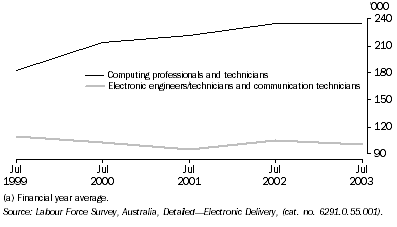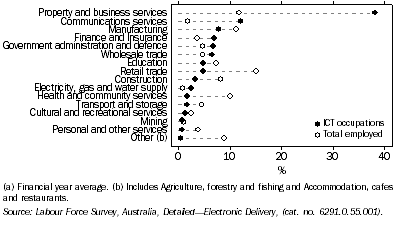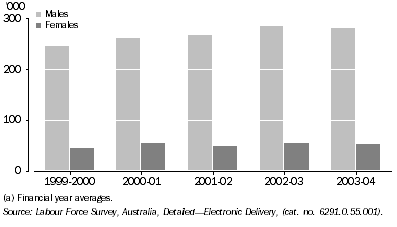Feature Article - Employment in information and communication technology (ICT)
This article was published as a spotlight in the January 2005 issue of Australian Labour Market Statistics (cat. no. 6105.0).
EMPLOYMENT IN INFORMATION AND COMMUNICATION TECHNOLOGY (ICT)
INTRODUCTION
ICT workers as a proportion of all employed persons has remained virtually unchanged over the last five years. The importance of ICT in enhancing long-term economic growth, increasing productivity and furthering technological development was acknowledged in the ABS discussion paper Measuring a Knowledge-based Economy and Society, An Australian Framework, 2002 (cat. no. 1375.0).
This article uses data from the Labour Force Survey (LFS) to analyse various characteristics of persons employed in ICT occupations (also referred to as ICT workers) in Australia over the past five years.
This article is an update from a previously released article that appeared in the January 2004 edition of Australian Labour Market Statistics (cat. no. 6105.0). This article includes more recent data, and takes into account revised population benchmarks introduced into the LFS for February 2004 (see Explanatory Notes, paragraphs 28-29).
CLASSIFICATION OF ICT OCCUPATIONS
ABS collections use the Australian Standard Classification of Occupations (ASCO) Second Edition (cat. no. 1220.0) to classify occupations according to skill level and skill specialisation. LFS data on occupations are collected for employed persons each February, May, August and November, and coded to the Unit Group (i.e. 4 digit) level of ASCO. Employed people with more than one job are coded to the occupation of their main job. For the purposes of this article, Unit Groups relating to ICT occupations have been grouped into two broader occupational groups: Computing professionals and technicians; and Electronic engineers/technicians and communication technicians, as shown in Table 1.
EMPLOYMENT IN ICT OCCUPATIONS
The total number of ICT workers increased for each of the three years to 2002-03 peaking at 339,700 persons, but declined to 335,200 persons in 2003-04. The proportion of total employed persons that are ICT workers has remained relatively stable over the last five years (4% in 2003-04).
The following table shows the number of persons employed in ICT occupations, and the number of all employed persons from 1999-2000 to 2003-04. Data shown are financial year averages.
Table 2, Employed persons, ICT occupation groups - 1999-2000 to 2003-04(a) |
|  |
 |  | 1999-2000 | 2000-01 | 2001-02 | 2002-03 | 2003-04 |  |
 |  | '000 | '000 | '000 | '000 | '000 |  |
|  |
| Computing professionals and technicians |  |  |  |  |  |  |
 | Information technology managers | 14.5 | 24.3 | 29.5 | 30.2 | 29.7 |  |
 | Computing professionals | 140.6 | 161.1 | 163.2 | 174.8 | 174.6 |  |
 | Computing support technicians | 27.3 | 28.4 | 29.4 | 29.7 | 30.7 |  |
 | Total | 182.5 | 213.8 | 222.1 | 234.7 | 235.0 |  |
| Electronic engineers/technicians and communication technicians |  |  |  |  |  |  |
 | Electrical and electronics engineers | 25.2 | 25.1 | 23.7 | 26.4 | 23.7 |  |
 | Electronic engineering associate professionals | 16.9 | 14.3 | 15.5 | 14.5 | 15.1 |  |
 | Electronic and office equipment tradespersons | 35.8 | 34.4 | 32.6 | 36.7 | 33.9 |  |
 | Communications tradespersons | 29.3 | 26.1 | 20.7 | 24.5 | 24.7 |  |
 | Electrical and telecommunications trades assistants | 2.5 | 3.0 | 2.8 | 2.9 | 2.8 |  |
 | Total | 109.6 | 102.9 | 95.3 | 105.0 | 100.2 |  |
| Total ICT workers | 292.1 | 316.8 | 317.4 | 339.7 | 335.2 |  |
| Total employed | 8,835.2 | 9,016.5 | 9,143.8 | 9,377.5 | 9,528.0 |  |
| Proportion of total employed that are ICT workers (%) | 3.3 | 3.5 | 3.5 | 3.6 | 3.5 |  |
|  |
| (a) Financial year average. |
| Labour Force Survey, Australia, Detailed - Electronic Delivery, (cat. no. 6291.0.55.001). |
Computing professionals continued to dominate the range of ICT professions in 2003-04, accounting for 52% of all ICT workers. Computing professionals covers system managers, designers, programmers and auditors, software designers, and applications and analyst programmers.
ICT employment growth remained strongest in the Computing professionals and technicians group, where the number of employed persons increased by 29% from 182,500 in 1999-2000 to 235,000 in 2003-04. However, there was no growth in the latest year. For the Electronic engineers/technicians and communication technicians group, the number of employed persons has fluctuated over the last five years. The number of persons employed in this occupation group decreased by 9% from a peak of 109,600 in 1999-2000 to 100,200 in 2003-04, despite an increase during the 2002-03 period.
Graph 3, Employed persons, ICT occupations - 1999-2000 to 2003-04(a)

UNEMPLOYMENT IN ICT
The LFS provides data on the last occupation of unemployed persons who had worked for two weeks or more within the previous two years. Of the 585,600 people unemployed for 2003-04 (average for the financial year), occupation was only able to be coded for 58% or 339,650 persons. In 2003-04, there were 12,100 people, on average, who were unemployed but had last worked (for two weeks or more in the previous two years) in an ICT occupation. They represented 4% of all unemployed persons who had occupation coded, which is similar to the proportion of employed persons working in ICT occupations.
HOURS WORKED
In 2003-04, the proportion of ICT workers employed full-time was higher than the proportion of all employed persons working full-time (93% compared with 71%).
Average hours usually worked each week by all ICT workers continued to be higher than all employed persons (41.4 hours compared with 36.9 hours) during 2003-04. This is largely due to the high proportion of ICT workers working in full-time positions. Average weekly hours usually worked by full-time ICT workers were slightly lower than those worked by all full-time workers (43.0 hours compared with 44.5 hours). For those ICT workers employed part-time, the average weekly hours usually worked were slightly higher than those of all persons employed part-time (20.4 hours compared with 18.0 hours).
Table 4, Employed persons, ICT workers and total employed - 2003-04(a) |
|  |
 |  | ICT workers
|  |  |
 |  | Computing(b) | Electronic and communication(c) | Total | Total employed |  |
|  |
| Employed |  |  |  |  |  |
 | Full-time (%) | 92.5 | 93.3 | 92.7 | 71.4 |  |
 | Part-time (%) | 7.5 | 6.7 | 7.3 | 28.6 |  |
 | Total (%) | 100.0 | 100.0 | 100.0 | 100.0 |  |
| Average weekly hours usually worked in all jobs |  |  |  |  |  |
 | Employed full-time (hours) | 43.2 | 42.7 | 43.0 | 44.5 |  |
 | Employed part-time (hours) | 21.5 | 17.5 | 20.4 | 18.0 |  |
 | Total (hours) | 41.5 | 41.0 | 41.4 | 36.9 |  |
|  |
| (a) Financial year average. |
| (b) Includes computing professionals and technicians. |
| (c) Includes electronic engineers/technicians and communication technicians. |
| Labour Force Survey, Australia, Detailed - Electronic Delivery, (cat. no. 6291.0.55.001). |
LOCATION
The highest concentration of ICT workers occurred in the ACT where they represented 8% of all employed persons. In contrast, the lowest concentration of ICT workers was in Tasmania, accounting for 2% of all employed persons in this state.There is a high concentration of ICT workers in capital cities. In 2003-04, 79% of all persons employed in ICT occupations were based in a capital city, compared with 63% of all employed persons.
Table 5, Employed persons, State/territory and capital city/balance of state - 2003-04(a) |
|  |
 |  | ICT workers
|  |  |  |
 |  | Computing(b) | Electronic and communication(c) | Total | Total employed | Proportion of total employed that are ICT workers |  |
 |  | % | % | % | % | % |  |
|  |
| State/territory |  |  |  |  |  |  |
 | New South Wales | 41.5 | 35.3 | 39.7 | 33.1 | 4.2 |  |
 | Victoria | 28.7 | 24.2 | 27.4 | 24.8 | 3.9 |  |
 | Queensland | 10.8 | 19.4 | 13.4 | 19.3 | 2.4 |  |
 | South Australia | 5.2 | 5.5 | 5.3 | 7.5 | 2.5 |  |
 | Western Australia | 6.7 | 10.4 | 7.8 | 10.2 | 2.7 |  |
 | Tasmania | 1.0 | 1.9 | 1.3 | 2.2 | 2.1 |  |
 | Northern Territory | 0.6 | 1.1 | 0.7 | 1.0 | 2.6 |  |
 | Australian Capital Territory | 5.4 | 2.0 | 4.4 | 1.8 | 8.4 |  |
| Capital city/balance of state |  |  |  |  |  |  |
 | Capital cities | 82.2 | 71.3 | 78.9 | 63.2 | 4.4 |  |
 | Balance of states/territories | 17.8 | 28.7 | 21.1 | 36.8 | 2.0 |  |
| Australia | 100.0 | 100.0 | 100.0 | 100.0 | 3.5 |  |
|  |
| (a) Financial year average. |
| (b) Includes computing professionals and technicians. |
| (c) Includes electronic engineers/technicians and communication technicians. |
| Labour Force Survey, Australia, Detailed - Electronic Delivery, (cat. no. 6291.0.55.001). |
| The proportions in this table have been created using unrounded estimates, and therefore may not add to 100%. |
INDUSTRY
Over the last five years, the Property and business services industry (which includes a Computer services subdivision) has been the main employer of ICT workers. In 2003-04, 38% of all ICT workers were employed in the Property and business services industry. Most ICT workers in this industry (86%) were in Computing professionals and technicians occupations. The second highest number of ICT workers were in the Communications services industry (12% or 40,600 persons), with 62% employed in Electronic engineers/technicians and communication technicians occupations.
Graph 6, Employed persons, Industry - 2003-04(a)

AGE
In 2003-04, almost one-third (32%) of ICT workers were in the 25-34 year age group. This was followed closely by the 35-44 year age group (31% of all ICT workers).
Table 7, Employed persons, Age - 2003-04(a) |
|  |
 |  | ICT workers | Total employed |  |
 |  | % | % |  |
|  |
| Age group (years) |  |  |  |
 | 15-24 | 10.5 | 18.0 |  |
 | 25-34 | 32.5 | 23.0 |  |
 | 35-44 | 31.2 | 24.1 |  |
 | 45-54 | 20.5 | 22.2 |  |
 | 55-64 | 5.1 | 11.1 |  |
 | 65 and over | 0.4 | 1.7 |  |
| Total | 100.0 | 100.0 |  |
|  |
| (a) Financial year average. |
| Labour Force Survey, Australia, Detailed - Electronic Delivery, (cat. no. 6291.0.55.001). |
SEX
Of the 335,200 ICT workers in 2003-04, 84% were males (282,600 persons). The proportion of ICT workers that are female has remained relatively steady at around 16% (52, 600 persons) over the past six years.
In 2003-04, male ICT workers represented 5% (282,600) of the total male employed population (5,289,500). In comparison, female ICT workers represented 1% (52,600) of the total female employed population (4,238,400).
Graph 8, Employed persons, ICT occupations - 1999-2000 to 2003-04(a)

COUNTRY OF BIRTH
In 2003-04, 37% of all ICT workers were overseas-born, compared to 25% of all employed persons. This is similar to the situation in 1999-2000 when 36% of all ICT workers were overseas-born compared to 25% of all employed persons.
Table 9, Employed persons, Country of birth - 1999-2000 and 2003-04(a) |
|  |
 | 1999-2000
| 2003-04
|  |
 | Born in Australia | Born overseas | Proportion of total employed born overseas | Born in Australia | Born overseas | Proportion of total employed born overseas |  |
 | '000 | '000 | % | '000 | '000 | % |  |
|  |
| ICT workers | 186.5 | 105.6 | 36.2 | 212.8 | 122.4 | 36.5 |  |
| Total | 6,652.2 | 2,183.0 | 24.7 | 7,177.6 | 2,350.4 | 24.7 |  |
| Proportion of total employed that are ICT workers (%) | 2.8 | 4.8 | . . | 2.9 | 5.2 | . . |  |
|  |
| . . not applicable |
| (a) Financial year average. |
| Labour Force Survey, Australia, Detailed - Electronic Delivery, (cat. no. 6291.0.55.001). |
FURTHER INFORMATION
For further information about statistics on information and communication technology workers, please contact Assistant Director, Innovation and Technology Statistics on Canberra (02) 6252 6181.
For email enquiries please contact Client Services on client.services@abs.gov.au
 Print Page
Print Page
 Print All
Print All